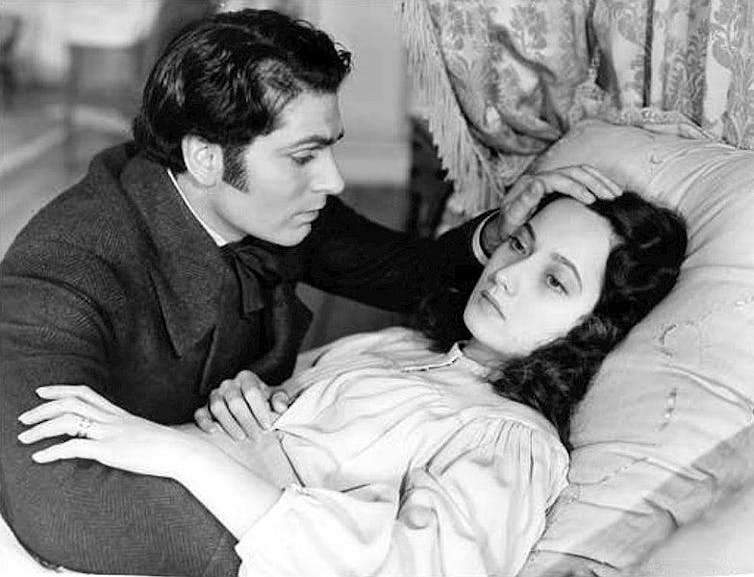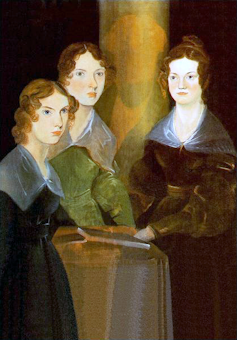Why Emily Brontë’s Wuthering Heights is a cult classic
- Written by Sophie Alexandra Frazer, Doctoral candidate in English, University of Sydney
In our series, Guide to the classics, experts explain key works of literature.
Nothing about the reception of Emily Brontë’s first and only published novel, Wuthering Heights, in 1847 suggested that it would grow to achieve its now-cult status. While contemporary critics often admitted its power, even unwillingly responding to the clarity of its psychological realism, the overwhelming response was one of disgust at its brutish and brooding Byronic hero, Heathcliff, and his beloved Catherine, whose rebellion against the norms of Victorian femininity neutered her of any claim to womanly attraction.
The characters speak in tongues heavily inflected with expletives, hurling words like weapons of affliction, and indulging throughout in a gleeful schadenfreude as they attempt to exact revenge on each other. It is all rather like a relentless chess game in hell. One of its early reviewers wrote that the novel “strongly shows the brutalising influence of unchecked passion”.
Moral philosopher Martha Nussbaum claims, however, that “we must ourselves confront the shocking in Wuthering Heights, or we will have no chance of understanding what Emily Brontë is setting out to do”. The reader must give herself over to the horror of Brontë’s inverted world.
She must jump, as it were, without looking to see if there is water below. It is a Paradise Lost of a novel: its poetry Miltonic, its style hyperbolic, and its cruelty relentless. It has left readers and scholars alike stumbling to locate its seemingly Delphic meaning, as we try to make sense of the Hobbesian world it portrays.
 Sir Laurence Olivier (Heathcliff) and Merle Oberon (Cathy) from the 1939 film adaptation. Photoplay/Wikimedia Commons
Sir Laurence Olivier (Heathcliff) and Merle Oberon (Cathy) from the 1939 film adaptation. Photoplay/Wikimedia Commons
The author remains as elusive as her enigmatic masterpiece. As new critical appraisals emerge in this, Emily Brontë’s bicentenary year, the scant traces she left of her personal life beyond her poetry and several extant diary papers, are re-fashioned accordingly.
Described as the “sphinx of the moors”, her obstinate mystery has lured countless pilgrims to the Haworth home in which she passed almost all of her life, and the surrounding moorlands that were the landscape of her daily walks and the inspiration for her writing. Brontë relinquished her jealous hold of the manuscript only after considerable pressure from her sister Charlotte, who insisted that it be published.
 The Bronte sisters painted by their brother Branwell: from left to right, Anne, Emily, and Charlotte. Wikimedia Commons
The Bronte sisters painted by their brother Branwell: from left to right, Anne, Emily, and Charlotte. Wikimedia Commons
Wuthering Heights was released pseudonymously under the name Ellis Bell, published in an edition that included her sister Anne’s lesser known work, Agnes Grey. Emily was to die just 12 months later, in December 1848.
As Brontë biographer Juliet Barker writes, the writer stubbornly maintained the pretence of health even in the final stages of consumption, insisting on getting out of bed to take care of her much loved dog, Keeper. She resisted death with remarkable self-discipline but, “her unbending spirit finally broken”, she acquiesced to a doctor’s attendance. It was by then too late; she was just 30.
After her sister’s death, Charlotte Brontë wrote two biographical prefaces to accompany a new edition of Wuthering Heights, instantiating the mythology both of her sister – “stronger than a man, simpler than a child” – and her infamous novel: “It is rustic all through. It is moorish, and wild, and knotty as the root of heath.”
Read more: Why Charlotte Brontë still speaks to us – 200 years after her birth
A feminist icon
It is that property of wildness that has compelled artists from Sylvia Plath to Kate Bush, whose 1978 hit single, Wuthering Heights, was representative of the magnetic pull of Brontë’s fierce heroine, Catherine. The novel has maintained its relevance in popular culture, and its author has risen to a feminist icon.
Wuthering Heights has maintained currency in pop culture, most famously in Kate Bush’s haunting 1978 hit of the same name.The elusiveness of the woman and the book that now seems an extension of her subjectivity, gives both a malleability that has seen Wuthering Heights transformed into various mediums: several Hollywood films, theatre, a ballet and, perhaps most incongruously, a detective novel. Brontë’s name is used to sell everything from food to dry-cleaning products.
Film versions have tended to indulge in a surfeit of romanticism, offering up visions of the lovers swooning atop windswept hills, most famously in the 1939 movie, with Laurence Olivier as a dashing Heathcliff, a heavily sanitised re-telling of what the promotional material billed as “the greatest love story of our time - or any time!” Andrea Arnold’s gritty, pared-back 2011 film is the notable exception; bleak and darkly violent, the actors speak in an at times unintelligible dialect, scrambling across a blasted wilderness as though they are animals.
Contrary to Charlotte Brontë’s revisioning, however, Wuthering Heights was not purely the product of a terrible divine inspiration, emerging partially formed from the granite rock of the Yorkshire landscape, to be hewn from Emily’s simple materials.
Instead, it is the work of a writer looking back to past Romantic forms, specifically the German incarnation of that aesthetic, infused with folkloric taboos and primal longings. Her tale of domestic gothic is housed in an intricately complex narrative architecture that works by repetition and doubling, at the fulcrum of which stands Catherine, the supremely defiant object of Heathcliff’s obsession.
At the novel’s core is the corrosiveness of love, with the titanic power of Shakespearean tragedy and the dialogic form of a Greek morality play. Two families, locked in internecine war and bound together by patrilineal inheritance, stage their abject conflict across the small geographical space that separates their respective households: the luxury and insipidity of the Grange, versus the shabby gentility, decay, and violence of the Heights.
A claustrophobic novel
It is a distinctly claustrophobic novel: although we read with a vague sense of the vastness of the moors that is its setting, the action unfolds, with few exceptions, in domestic interiors. Despite countless readings, I can conjure no distinct image of the Grange. But the outline of the Heights, with each room unfolding into yet another set of rooms, labyrinthine and imprisoning, has settled into my mind. The deeper you enter into the space of the Heights - the space of the text - the more bewildering the effect.
The love between Heathcliff and Catherine exists now as a myth operative outside any substantial relationship to the novel from which the lovers spring. It is shorthand in popular culture for doomed passion. Much of this hyper-romance gathers around Catherine’s declaration of Platonic unity with her would-be lover: “I am Heathcliff – he’s always, always in my mind.” Yet their relationship is never less than brutal.
What is it about their unearthly union, with its overtones of necrophilia and incestuous desire, that so captivates us, and why does Emily Brontë privilege this form of explicitly masochistic, irrevocable and unattainable love?
Read more: How incest became part of the Brontë family story
Brontë’s great theme was transcendence, and I would suggest that it is the metaphysical affinity that solders these two lovers that so beguiles us. The greediness of their feeling for each other resembles nothing in reality. It is hyperreal, as Catherine and Heathcliff do not aspire so much as to be together, as to be each other. Twinned in that shared commitment and to the natural world that was the hunting-ground of their childhood play, they try, with increasing desperation, to get at each other’s souls.
 Penistone Crag - a rock at the top of Ponden Kirk - is believed to have been Emily Brontë’s inspiration for the place where Cathy and Heathcliff went to be alone. Aaron Collis/Wikimedia Commons, CC BY-SA
Penistone Crag - a rock at the top of Ponden Kirk - is believed to have been Emily Brontë’s inspiration for the place where Cathy and Heathcliff went to be alone. Aaron Collis/Wikimedia Commons, CC BY-SA
This is not a physically erotic coupling: the body is immaterial to their love. It is a very different notion of desire to that of Jane Eyre and Rochester, for instance, in Charlotte Brontë’s Jane Eyre, which is very fleshy indeed. Both Catherine and Heathcliff want to get under each other’s skin, quite literally, to join and become that singular body of their childhood fantasies. It is a dream, then, of total union, of an impossible return to origins. It is not heavenly in its transcendence, but decidedly earthly. “I cannot express it”, Catherine tells her nurse Nelly Dean, who is our homely, yet not so benign, narrator:
But surely you and everybody have a notion that there is, or should be, an existence of yours beyond you. What were the use of my creation if I were entirely contained here? My great miseries in this world have been Heathcliff’s miseries … my great thought in living is himself. I all else perished, and he remained, I should still continue to be.
This notion of the self eclipsing its selfish form seems impossible for us to conceive in an age where one’s individuality is sacred. It is, however, the essence of Catherine’s tragedy: her search for her self’s home among the men who circle her is futile. Nevertheless, Emily Brontë’s radical statement of a shared ontology grounds the eroticism between the pair so that we cannot look away; and neither it seems, can the other characters in the novel.
The book’s structure is famously complex, with multiple narrators and a fluid style that results in one focalising voice shading into another. The story proper begins with Lockwood, a stranger to the rugged moorlands, a gentleman accustomed to urban life and its polite civilisations.
The terrifying nightmare he endures on his first night under Heathcliff’s roof, and the gruesomely violent outcome of his fear sets in motion the central love story that pulls all else irresistibly to it. Heathcliff’s thrice-repeated invocation of Catherine’s name, which Lockwood finds written in the margins of a book and mistakenly believes to be “nothing but a name”, works as an incantation, summoning the ghost of the woman who haunts this book.
Emily Brontë speaks of dreams, dreams that pass through the mind “like wine through water, and alter the colour” of thoughts. If the experience of reading Wuthering Heights feels like a suspension in a state of waking nightmare, what a richly-hued vision of the fantastical it is.
Authors: Sophie Alexandra Frazer, Doctoral candidate in English, University of Sydney
Read more http://theconversation.com/why-emily-brontes-wuthering-heights-is-a-cult-classic-100748





